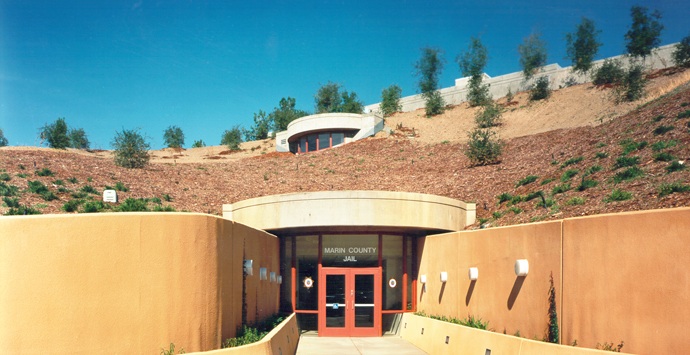When architects design death chambers

For only $29.99, you can "build and manage your own maximum security prison." Really.
It's a video game, of course, called Prison Architect. Instead of planning the brave new worlds of Minecraft or SimCity, players can engross themselves in the world of prison design. Rather than simply being a warden, the player serves as architect, "choosing where to put lights, drains and how they connect together," notes PC Gamer. And more: A tutorial from the indie maker, U.K.'s Introversion Software, asks initiates to design an execution chamber and plug in their brand-new electric chair to the utility grid.
It's a silly little game. But a few architects are not amused.
In a recent letter on the American Civil Liberties Union (ACLU) Web site, architect and activist Raphael Sperry writes that recent hunger strikes by prisoners in Guantanamo Bay, Cuba, and California's Pelican Bay reflect "intolerable living conditions." He concludes that "these prisoners said, in effect, that they'd rather die than go on living in these buildings."
Architects: Just say no
Sperry's shoestring nonprofit, Architects/ Designers/ Planners for Social Responsibility (ADPSR), has attracted national attention recently with its Prison Alternatives Initiative. Sperry and supporters argue that architects have a moral obligation to turn down work designing these places.
About a thousand like-minded individuals have signed their related petition, asking the American Institute of Architects (AIA) "to prohibit the design of spaces for killing, torture and cruel, inhuman or degrading treatment."
The idea of architects designing death camps is akin to doctors being used as executioners, Sperry says. And the American Medication Association prohibits its members from doing that.
This a powerful point, and it raises a good question. Architects follow strict codes of ethics ordered by each state to use their craft to protect public health, safety and welfare. Couldn't AIA easily supplement these state rules to protect the public by forbidding member architects from designing places of torture? Or porn movie production houses? Or fancy homes for leaders of drug cartels and known terrorist groups?
Prisons need architects
Maybe. But we still need architects to design correctional facilities. More than ever.
We need them to design our criminal justice infrastructure. Sperry and his supporters say, "It's time to stop building prisons." But that hasn't been the trend: ADPSR notes that incarceration rates have increased by 700 percent since about 1990. The United States sends more people to jail than any other country. So it needs better-built solutions -- humane places designed to protect the public while reducing recidivism.
It's a matter of life and death. Not a Linux-coded pastime.
My neighbor has actually played the game as a job. He's one of the most experienced prison architects I've met. Actually Ken Underwood, FAIA, is an accomplished all-around architect, but he has earned a strong reputation over the years for his ability to produce cost-effective, well-designed and humane correctional facilities.
A tool of reform?

Underwood rose to prominence during a time when prison design (like prison itself) was seen by many as a tool of reform and rehabilitation. Remember the 1960s and 1970s? Corrections could correct -- and even help elevate lost souls from the underclass to find a fresh new start.
That changed quickly.
Ken and other architects have told me about more recent years, when authorities commissioning prisons seemed to lose their focus on the potential of corrections. Demagoguing politicians railed against the costs of prisons. (One called an East Coast project "the marble prison" because it had a small amount of waste marble chips in the concrete mix.) The public applauded. Corrections authorities responded, limiting costly windows and space enclosed for such "luxuries" as dining, exercise and counseling. Instead, we've been spending as little as possible per cell. The idea of building for basic comforts is seen today as coddling, not humanism.
Cells that punish
We're taking a harder line on criminals. Prison has become a means to take revenge and inflict punishment, by limiting physical movement and social interaction. Yet as Sperry's group notes, fully half of our prison population -- a million inmates -- are behind bars for nonviolent offenses. And the science shows that the disciplinary approach of creating places that inflict pain or reinforce punishment tend to fail -- in jail and after release, doing irreparable psychological harm. As Sperry explains, they "crush individuality and individual freedom" in ways that prove "antithetical to positive social goals such as rehabilitation and peaceful coexistence."
ADPSR has earned some funding and a smattering of support for its efforts. Sperry was the first architect to earn a grant from the George Soros nonprofit Open Society Foundations, and groups like Canada's Prison Moratorium Action Coalition have mobilized behind the cause.
It's naive to think possible the banning of all prison construction or to call for large-scale implementation of "community-based alternatives to incarceration," as ADPSR does. Even the prison design boycott, which the group has called for, would simply leave the design to engineers, contractors and corrections authorities. And many provisions in the building codes that architects champion may not be mandated in correctional facilities.
Starting with small steps is sensible: First, by bringing together the best architects in America to help solve the issues of cruelty through detention. Second, to provide models of proper incarceration and prisoner care for use in jails, corrections centers, prisons and immigrant detention camps. (A design competition would be fast way to elicit good ideas and publicize them well.) Last, to allow architects and social scientists to tour our prisons -- the best and the worst of them -- to learn from past errors and see the damage they inflict.
Prison design is not a game. It's a serious step architects can take toward solving the decades-old prisons crisis.
This post was originally published on Smartplanet.com